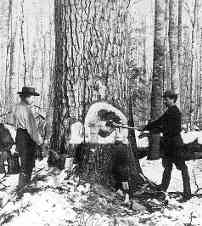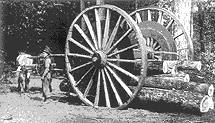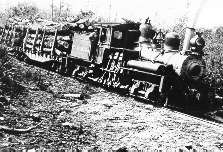| During the 19th century,
Michigan's forests yielded more money and created more millionaires
than did all the gold mined during California's Gold Rush. In turn,
this wealth fueled the great financial and industrial rise of the state
at the beginning of the 20th century.
Before the lumber boom, most of Michigan was densely forested
wilderness. Though Native Americans were the first to fell trees in
Michigan, their modest needs had little impact upon the forests. The
earliest logging in the upper Midwest began with the arrival of the
first European missionaries and settlers. The French built missions,
forts, and fur-trading posts out of pine. |
 |
White pine, the most common tree, was preferred because it was easy to
work and grew straight and tall. The largest specimens were 300 years
old, 200 feet tall and up to 8 feet in diameter. Other abundant species
were maple, elm, basswood and yellow pine.
The French followed a tradition that had already proved disastrous to
the forests of Europe - clear-cutting. When the British arrived, they
cut many hardwoods to build their warships and merchant vessels.
Initially the areas that were clear-cut were relatively small, but as
the demand for lumber increased, so did the practice of clear-cutting.
Commercial lumber production began in the 1830s, with the appearance of
the first sawmills in the Saginaw area. Saginaw was the perfect place to
begin, because it had more than three million acres of white pine
forests and a network of over 1,500 miles of navigable rivers and
streams. The Saginaw River had a total length of 864 miles. This
resource was critical because the only method of transporting the logs
from forest to sawmill was to float them down the rivers.

Most of the lumber was cut during winter because the best way to
transport the large logs to the rivers was by horse-drawn sleds. The
logs were hauled to the banks of the frozen rivers where they were
stacked and held until the spring thaw. After the spring thaw, they were
floated down river to retention ponds, where they were sorted by company
and then sent to their respective sawmills for cutting.
No Axes to Grind
A major advance was achieved with the introduction of the circular
saw into mill operations around 1850. Logging expanded rapidly, and by
the end of the Civil War, Michigan was the top lumber-producing state in
the Union, producing more than 500 million board feet of lumber per
year.
Most trees were felled by axes until the 1870s, when crosscut saws were
improved so that they could be used to cut down standing timber. Two
other innovations during the 1870s made logging a year-round affair. Big
Wheels - logs suspended from chains attached to the axle connecting a
set of enormous wheels and drawn by a team of horses - were invented as
an alternative to sled transportation.

In 1876, the first narrow gauge railroads were built to haul logs and
they opened up immense new areas to logging that were previously
inaccessible. The state granted huge tracts of timberlands to logging
companies to get them to improve roads and build new rail lines and by
1889, at least eighty-nine narrow gauge railroads were in operation.

Measure Once, Cut Twice?
Logging companies often did not confine their cutting to the area
they had purchased. There was the practice of "logging a round
forty," which meant buying forty acres and then cutting the timber
around it in all directions far beyond the boundaries of the area to
which title had been secured. By 1900 most of the pine in the Lower
Peninsula was gone. Pine logging in the Upper Peninsula began to assume
greater importance in the 1880s, and the virgin stands lasted until
about 1920. The peak of Michigan's great timber harvest was reached in
1889-1890 when mills cut a total of 5.5 billion board feet of lumber,
mostly pine.
By the boom's end, logging had stripped 19.5 million acres, none of
which was replanted, leaving vast tracts of barren wasteland. The lumber
barons attempted to unload the now worthless land by setting up
demonstration farms, using large amounts of fertilizer to convince
unsuspecting buyers that the soil was suitable for farming. Many small
plots were sold to people who put up their life savings, only to find
out after a couple of unproductive growing seasons that they had been
cheated. Most of the barren land couldn't be sold under any
circumstances and it reverted to state ownership as the lumber barons
abandoned it because they didn't want to continue paying taxes on it.
During the depression of the 1930s, one of the projects assigned to the
Civilian Conservation Corps (CCC), made up of out-of-work young men, was
to repair the damage done to the nation's forests by clear-cutting.
The CCC planted millions of seedlings and over time most of Michigan's
barren areas were reforested. However, some areas known as "stump
prairies" still exist, even though it has been over a century since
they were stripped of trees.
Today, over half of Michigan's land mass is covered by forests.
Logging, which never disappeared altogether, continues, especially in
the state's northern counties, but it is being done very selectively,
to preserve and protect the remaining old-growth forests. Tree farming
began in 1941, and now accounts for the overwhelming majority of the
nearly 675 million board-feet of lumber that Michigan produces annually.
Michigan also produces over 15 million Christmas trees each year,
representing approximately 15% of the nation's supply.
|







